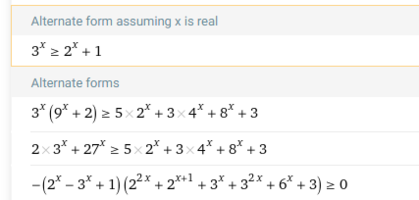Yes, it should say s(x) > q(x).
We start by recognizing that
27x−8x−3∗4x+2∗3x−5∗2x−3≥0⟺27x+2∗3x≥8x+3∗4x+5∗2x+3
Now we do not know initially where (if anywhere) the first inequality is true, but we know that the first inequality is equivalent to the second and that the second involves no negatives.
To avoid errors and make things clearer, we use function notation.
Define p(x)=27x+2∗3xand q(x)=8x+3∗4x+5∗2x+3.
So our second inequality can be expressed very simply as
p(x)≥q(x)
At this point, we still have no clue what values of x (if any) make that inequality true. We can also see that p(x) and q(x) are not functions that are really easy to work with unless x = 0 or x = 1. However, we are interested in positive integers so let’s see what happens at x = 1.
p(1)=271+2∗31=27+6=33.q(1)=81+3∗41+5∗21+3=8+12+10+3=20+13=33⟹p(1)=q(1).
Now perhaps we can work with nicer functions for integers greater than 1.
Define r(x)=27x⟹p(x)>r(x) for all real x ∵ 2∗3x>0.Define s(x)=10∗8x⟹s(x)>q(x for all real x >1∵8x>4x>2x and 8x>3 for all real x>1.
What we know so far is p(x) > r(x) for all x, p(1) = q(1), and s(x) > q(x) for all x > 1.
Now if we can show that r(x) > s(x) for all integers greater than 1, we are about done. But that is easy.
We show r(2) > s(2) > 0 and r(k + 1)/s(k+1) > r(k)/s(k), and we have an inductive proof that r(n) > s(n) for any integer > 1.
Thus, for integer n > 1, p(n) > r(n) > s(n > q(n) so p(n) > q. And p(1) = q(1). Therefore p(n)
≥ q(n) for any positive integer n.


